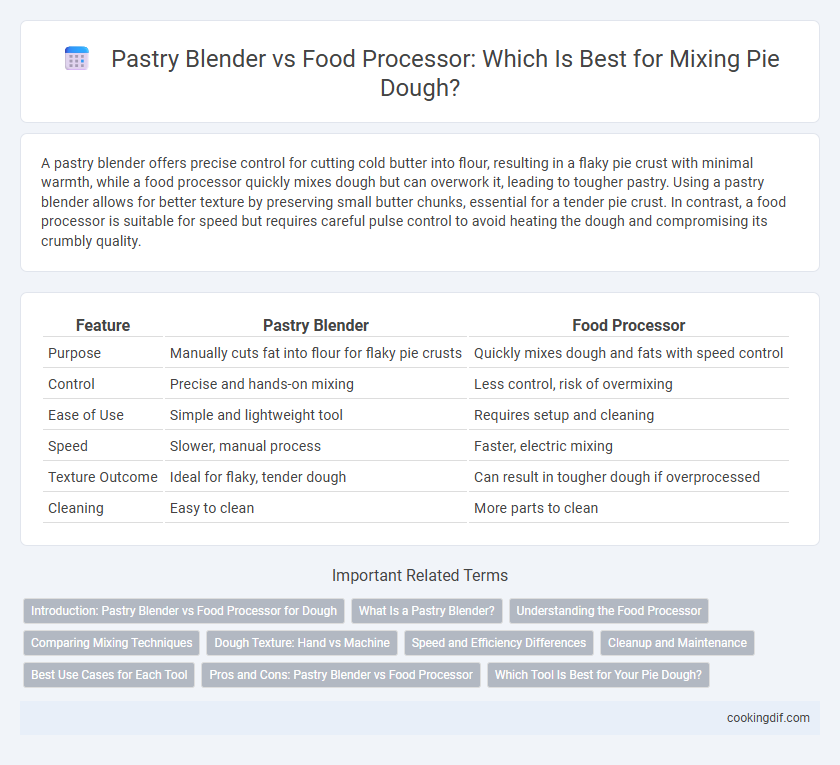A pastry blender offers precise control for cutting cold butter into flour, resulting in a flaky pie crust with minimal warmth, while a food processor quickly mixes dough but can overwork it, leading to tougher pastry. Using a pastry blender allows for better texture by preserving small butter chunks, essential for a tender pie crust. In contrast, a food processor is suitable for speed but requires careful pulse control to avoid heating the dough and compromising its crumbly quality.
Table of Comparison
| Feature | Pastry Blender | Food Processor |
|---|---|---|
| Purpose | Manually cuts fat into flour for flaky pie crusts | Quickly mixes dough and fats with speed control |
| Control | Precise and hands-on mixing | Less control, risk of overmixing |
| Ease of Use | Simple and lightweight tool | Requires setup and cleaning |
| Speed | Slower, manual process | Faster, electric mixing |
| Texture Outcome | Ideal for flaky, tender dough | Can result in tougher dough if overprocessed |
| Cleaning | Easy to clean | More parts to clean |
Introduction: Pastry Blender vs Food Processor for Dough
A pastry blender features sturdy metal blades designed for cutting butter into flour, producing crumbly dough ideal for pie crusts. Food processors use sharp blades to rapidly combine ingredients, offering speed but risking over-mixing that can toughen dough. Choosing between the two tools depends on the desired dough texture and control over mixing precision.
What Is a Pastry Blender?
A pastry blender is a specialized kitchen tool with multiple curved metal wires attached to a handle, designed specifically to cut cold butter or shortening into flour for pie crust dough. Unlike a food processor, which uses high-speed blades to rapidly combine ingredients, the pastry blender allows more control over texture, producing a crumbly mixture essential for flaky pastry layers. Its manual operation minimizes heat transfer, preventing fat from melting and ensuring a tender, flaky crust.
Understanding the Food Processor
A food processor efficiently mixes dough by quickly combining ingredients with sharp, rotating blades, saving time compared to manual methods. It handles larger batches and maintains a consistent texture, ideal for crusts requiring uniform flakiness. However, precise control can be challenging, potentially leading to overworked dough that affects pie crust tenderness.
Comparing Mixing Techniques
A pastry blender uses manual pressure and cutting motions to evenly incorporate fat into flour, resulting in a crumbly dough texture ideal for flaky pies. A food processor rapidly chops and mixes ingredients with high-speed blades, producing a more uniform dough but risking overmixing and gluten development. Choosing between these techniques affects dough consistency, with the pastry blender offering greater control and the food processor providing speed and efficiency.
Dough Texture: Hand vs Machine
A pastry blender creates a coarse, flaky dough texture by manually cutting cold butter into flour, preserving small butter chunks essential for tender pie crusts. Food processors generate a finer, more uniform dough by rapidly combining ingredients, which can result in a less flaky, denser texture if over-processed. For optimal pie dough texture, using a pastry blender allows better control over butter size and dough consistency compared to the machine's fast, intensive mixing.
Speed and Efficiency Differences
A pastry blender offers precise control and is ideal for small batches, allowing for a flaky texture by cutting butter into flour without overworking the dough. Food processors deliver unmatched speed and efficiency, quickly combining ingredients for large quantities but risk warming the dough and overmixing. Choosing between the two depends on desired dough consistency and batch size; pastry blenders excel in delicate, slow mixing, while food processors save time for bulk preparation.
Cleanup and Maintenance
A pastry blender offers straightforward cleanup with its simple design, requiring only a quick wash of its solid blades and handle, which prevents dough from sticking in hard-to-reach areas. Food processors demand thorough cleaning due to multiple components, including sharp blades and a bowl where dough can easily cling, necessitating careful disassembly and drying to avoid residue buildup. Maintaining a pastry blender generally saves time and effort compared to the intricate cleaning routine of a food processor used for mixing dough.
Best Use Cases for Each Tool
A pastry blender excels at gently cutting cold butter into flour, preserving flaky layers crucial for pie crusts, making it ideal for small batches or precise dough textures. Food processors quickly and efficiently combine ingredients, perfect for larger batches or when speed is essential, but they risk overworking the dough, leading to tougher crusts. Choosing between the two depends on the desired dough texture and batch size, with the pastry blender favored for traditional flaky results and the food processor suited for convenience and volume.
Pros and Cons: Pastry Blender vs Food Processor
A pastry blender excels in creating crumbly, flaky pie crusts by allowing precise control over cutting cold butter into flour, resulting in a consistent texture without overworking the dough. In contrast, a food processor offers speed and convenience, quickly combining ingredients but risks overheating and toughening the dough if not pulsed carefully. Choosing between a pastry blender and food processor depends on balancing desired dough texture and time efficiency, with the blender favored for traditional techniques and the processor for modern convenience.
Which Tool Is Best for Your Pie Dough?
A pastry blender offers precise control and ensures a flaky texture by cutting cold butter into flour without overly warming the dough, making it ideal for traditional pie crusts. A food processor provides speed and convenience, quickly combining ingredients but risks overworking the dough, leading to tougher crusts. For optimal pie dough results, choose a pastry blender when aiming for delicate flakiness and a food processor for efficient preparation of sturdier crusts.
Pastry blender vs food processor for mixing dough Infographic

 cookingdif.com
cookingdif.com